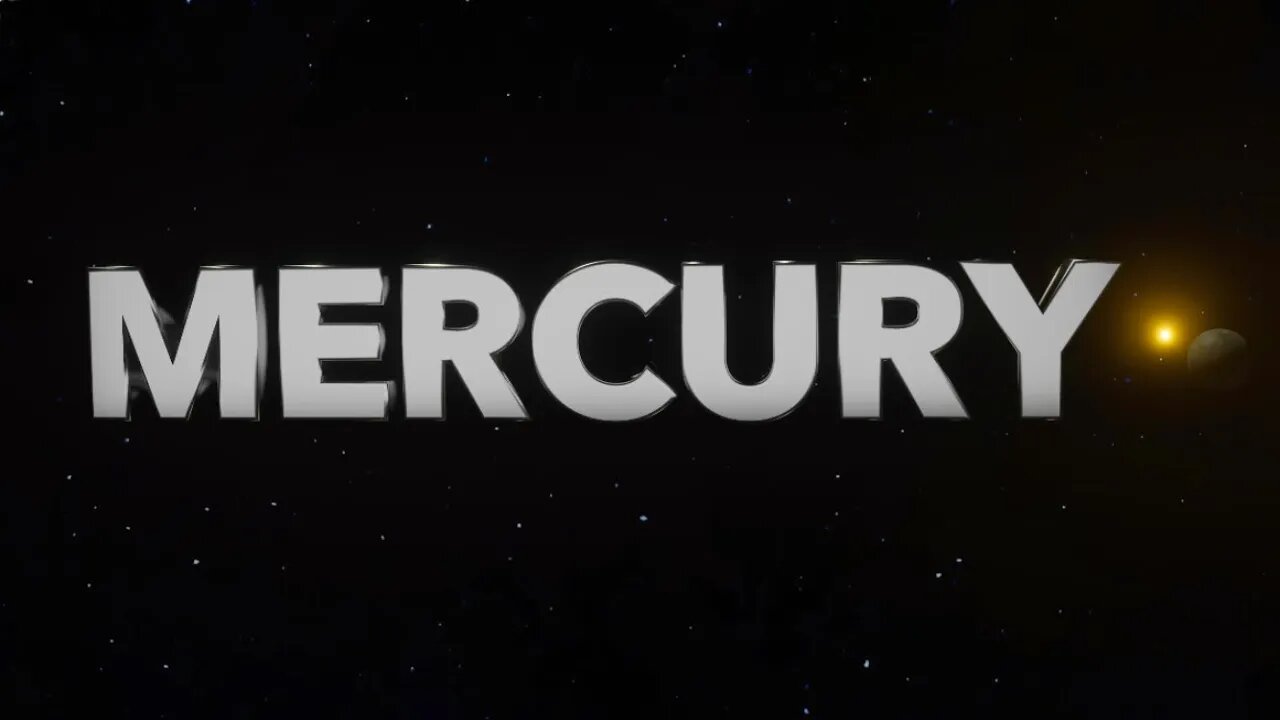Premium Only Content

Mercury Blender Simulation In 4K
Mercury - The Planet. I'm back again with another Blender project, this time I created the planet Mercury, the planet that is closest to our Solar System's Sun.
Wikipedia: Mercury is the smallest planet in the Solar System and the closest to the Sun. Its orbit around the Sun takes 87.97 Earth days, the shortest of all the Sun's planets. It is named after the Roman god Mercurius (Mercury), god of commerce, messenger of the gods, and mediator between gods and mortals, corresponding to the Greek god Hermes (Ἑρμῆς). Like Venus, Mercury orbits the Sun within Earth's orbit as an inferior planet; its apparent distance from the Sun as viewed from Earth never exceeds 28°. This proximity to the Sun means the planet can only be seen near the western horizon after sunset or the eastern horizon before sunrise, usually in twilight. At this time, it may appear as a bright star-like object, but is more difficult to observe than Venus. From Earth, the planet telescopically displays the complete range of phases, similar to Venus and the Moon, which recurs over its synodic period of approximately 116 days. Due to its synodic proximity to Earth, Mercury is most often the closest planet to Earth, with Venus periodically taking this role.
Mercury rotates in a way that is unique in the Solar System. It is tidally locked with the Sun in a 3:2 spin–orbit resonance, meaning that relative to the fixed stars, it rotates on its axis exactly three times for every two revolutions it makes around the Sun. As seen from the Sun, in a frame of reference that rotates with the orbital motion, it appears to rotate only once every two Mercurian years. An observer on Mercury would therefore see only one day every two Mercurian years.
Mercury's axis has the smallest tilt of any of the Solar System's planets (about 1⁄30 degree). Its orbital eccentricity is the largest of all known planets in the Solar System; at perihelion, Mercury's distance from the Sun is only about two-thirds (or 66%) of its distance at aphelion. Mercury's surface appears heavily cratered and is similar in appearance to the Moon's, indicating that it has been geologically inactive for billions of years. Having almost no atmosphere to retain heat, it has surface temperatures that vary diurnally more than on any other planet in the Solar System, ranging from 100 K (−173 °C; −280 °F) at night to 700 K (427 °C; 800 °F) during the day across the equatorial regions. The polar regions are constantly below 180 K (−93 °C; −136 °F). The planet has no natural satellites.
Two spacecraft have visited Mercury: Mariner 10 flew by in 1974 and 1975; and MESSENGER, launched in 2004, orbited Mercury over 4,000 times in four years before exhausting its fuel and crashing into the planet's surface on April 30, 2015. The BepiColombo spacecraft is planned to arrive at Mercury in 2025.
Physical characteristics: Mercury is one of four terrestrial planets in the Solar System, and is a rocky body like Earth. It is the smallest planet in the Solar System, with an equatorial radius of 2,439.7 kilometres (1,516.0 mi). Mercury is also smaller—albeit more massive—than the largest natural satellites in the Solar System, Ganymede and Titan. Mercury consists of approximately 70% metallic and 30% silicate material.
Orbit, rotation, and longitude
Orbit of Mercury (2006): Animation of Mercury's and Earth's revolution around the Sun. Mercury has the most eccentric orbit of all the planets in the Solar System; its eccentricity is 0.21 with its distance from the Sun ranging from 46,000,000 to 70,000,000 km (29,000,000 to 43,000,000 mi). It takes 87.969 Earth days to complete an orbit. The diagram illustrates the effects of the eccentricity, showing Mercury's orbit overlaid with a circular orbit having the same semi-major axis. Mercury's higher velocity when it is near perihelion is clear from the greater distance it covers in each 5-day interval. In the diagram, the varying distance of Mercury to the Sun is represented by the size of the planet, which is inversely proportional to Mercury's distance from the Sun. This varying distance to the Sun leads to Mercury's surface being flexed by tidal bulges raised by the Sun that are about 17 times stronger than the Moon's on Earth. Combined with a 3:2 spin–orbit resonance of the planet's rotation around its axis, it also results in complex variations of the surface temperature. The resonance makes a single solar day (the length between two meridian transits of the Sun) on Mercury last exactly two Mercury years, or about 176 Earth days.
Created in Blender 3.4.1 on April 6th, 2023.
Thanks to Free3D.com for a gray colorless version of the Mariner 10 3D model. I added in the color and shading.
Music: Hades Decent by Unknown Artist.
If you enjoyed this video, please smash that like button, & leave a comment or a question. You can always subscribe to my channel as well. Thanks for stopping by!
-
 1:10:32
1:10:32
Wendy Bell Radio
7 hours agoPet Talk With The Pet Doc
27.5K18 -
 LIVE
LIVE
ttvglamourx
1 hour ago $0.51 earnedHAPPY SATURDAY !DISCORD
193 watching -
 18:53
18:53
Wrestling Flashback
23 days ago $8.94 earned10 WWE Wrestlers Who Ruined Their Bodies Wrestling Too Long
21.7K4 -
 LIVE
LIVE
Amarok_X
2 hours ago🟢LIVE ARC RAIDERS | TOPSIDE FOR SCRAPPY | PREMIUM CREATOR | VETERAN GAMER
197 watching -
 27:03
27:03
The Kevin Trudeau Show Limitless
3 days agoThey're Not Hiding Aliens. They're Hiding This.
55.6K74 -
 22:17
22:17
MetatronGaming
6 days agoI spent 7 days in the 1980s
19.1K8 -
 LIVE
LIVE
FrizzleMcDizzle
2 hours agoGRINDING new NightReign content - COME HANG
79 watching -
 26:02
26:02
Planet 3 Outdoors
28 days ago $1.20 earnedBuilding a Treehouse and Catch & Cook a Giant Fish by the River 🌧️🍳
18.3K5 -
 LIVE
LIVE
Shield_PR_Gaming
3 hours ago12/06/25 | Mobius Final Fantasy Reborn & other games!? Follow me on PickAx (referral in description)
34 watching -
 34:21
34:21
Demons Row
17 hours ago $21.51 earnedJason Momoa Reveals His REAL Life in the REDRUM Motorcycle Club ⚠️🔥
163K30